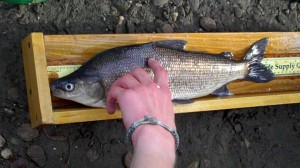Scientist says Chatanika whitefish are making a comeback
June 2, 2010

Carin Stephens
907-322-8730
6/2/10
Humpback whitefish in the Chatanika River are recovering from a population crash in the 1980s, according to a scientist at the University of Alaska Fairbanks.
In the early 1980s, the Chatanika River supported a popular, sport spear fishery for humpback whitefish and least cisco. In 1987, the fishery peaked when fishermen caught more than 25,000 fish during the fall spawning season. The Alaska Department of Fish and Game placed limits on the fishery but population studies showed that the high harvest rates were unsustainable. The fishery was closed from 1994 to 2007, when it was reopened on a limited, personal use permit-only basis.
Trent Sutton, associate professor of fisheries at the UAF School of Fisheries and Ocean Sciences, is leading studies of both humpback whitefish and least cisco in the Chatanika River. The two-year studies began in 2008.
The first study, led by Sutton’s graduate student, Lorena Edenfield, focused on the population dynamics of humpback whitefish and least cisco. They checked length, weight and age of the fish and compared those measurements to data collected before and after the fishery collapse.
“What we found is that when you compare size, age, and growth and mortality rates, humpback whitefish appear to have recovered,” said Sutton. “If you look at size structure now, you will find full distribution out there of all sizes.”
The data on the least cisco tells a different story. Their population suffered the most when the fishery collapsed, Sutton said. “We are being cautious about the least cisco. They don’t seem to have recovered yet.”
The second study, led by Sutton’s graduate student, Aaron Dupuis, looked at the humpback whitefish’s movement patterns and spawning habitat use. Humpback whitefish historically spawned near the Elliott Highway bridge. In June 2008, Dupuis collected and tagged 60 humpback whitefish in the lower Chatanika. He then used radio telemetry to track their movement. The population split into two groups: one group moved towards the Elliott Highway to spawn, and the second group stayed downriver.
In 2009, Dupuis tagged an additional 100 fish in Minto Flats. Of those, 61 went up the Chatanika River and split into two groups. One group went to the Elliott Highway bridge to spawn at their traditional spawning grounds. The second group stayed downriver.
“The really interesting thing is that the other 39 fish disappeared, for a while,” said Sutton.
Using aerial surveys, Dupuis found them. They had left Minto Flats, and entered the Tanana River, where they spawned between Fairbanks and the mouth of the Salcha River. Dupuis and Sutton say this is a previously unknown spawning area for humpback whitefish.
“It’s really a new discovery,” said Sutton. “It raises all sorts of questions. Are the fish in the newly discovered spawning area genetically different from those that spawn in the Chatanika River? A separate spawning stock could have implications for management of the subsistence, sport and personal use fisheries.”
Both projects are supported by the UAF School of Fisheries and Ocean Sciences with field support from the Alaska Department of Fish and Game and the U.S. Fish and Wildlife Service.
The UAF School of Fisheries and Ocean Sciences conducts world-class marine and fisheries research, education and outreach across Alaska, the Arctic and Antarctic. 60 faculty scientists and 150 students are engaged in building knowledge about Alaska and the world's coastal and marine ecosystems. SFOS is headquartered at the University of Alaska Fairbanks, and serves the state from facilities located in Seward, Juneau, Anchorage and Kodiak.
ADDITIONAL CONTACTS: Trent Sutton, Associate Professor of Fisheries, 907-474-7285, tmsutton@alaska.edu
ON THE WEB: www.sfos.uaf.edu
CS/6-2-10/243-10


